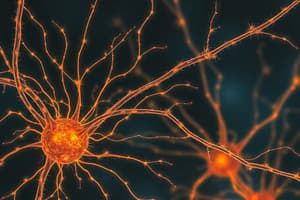Podcast
Questions and Answers
Which type of filament is the thinnest in the cytoskeleton?
Which type of filament is the thinnest in the cytoskeleton?
- Actin filaments (correct)
- Intermediate filaments
- Keratins
- Microtubules
Microtubules are primarily composed of actin protein subunits.
Microtubules are primarily composed of actin protein subunits.
False (B)
What is the primary function of intermediate filaments?
What is the primary function of intermediate filaments?
To provide mechanical strength and stability to cells.
The dynamic behavior of actin filaments is known as ______.
The dynamic behavior of actin filaments is known as ______.
Which of the following statements about microtubules is FALSE?
Which of the following statements about microtubules is FALSE?
Intermediate filaments are more dynamic than actin filaments.
Intermediate filaments are more dynamic than actin filaments.
Name one function of actin filaments.
Name one function of actin filaments.
Microtubules are made up of ______ protein subunits.
Microtubules are made up of ______ protein subunits.
Match the following filament types with their corresponding characteristics:
Match the following filament types with their corresponding characteristics:
Which filament type is involved in forming the core of microvilli?
Which filament type is involved in forming the core of microvilli?
Flashcards are hidden until you start studying
Study Notes
Cytoskeleton
- The cytoskeleton is a dynamic network of fibers that provides structural support, shape, and motility to cells. It is composed of three main types of filaments: actin filaments, microtubules, and intermediate filaments.
Actin Filaments
- Composed of actin protein subunits.
- Diameter: ~7 nm; the thinnest filament in the cytoskeleton.
- Functions:
- Maintain cell shape and support.
- Facilitate cell movement through processes like amoeboid movement.
- Involved in muscle contraction (along with myosin).
- Form the core of microvilli and other cell projections.
- Dynamic behavior: constantly polymerizing and depolymerizing (treadmilling).
Microtubules
- Composed of tubulin protein subunits (alpha and beta tubulin).
- Diameter: ~25 nm; the thickest filament in the cytoskeleton.
- Functions:
- Provide structural support and shape to cells.
- Serve as tracks for intracellular transport (motor proteins like kinesin and dynein move cargo along microtubules).
- Form the spindle apparatus during cell division (mitosis).
- Major component of cilia and flagella, aiding in cell motility.
- Dynamic behavior: exhibit rapid growth and shrinkage (dynamic instability).
Intermediate Filaments
- Composed of various protein subunits (e.g., keratins, vimentin, neurofilaments).
- Diameter: ~10 nm; intermediate in size between actin filaments and microtubules.
- Functions:
- Provide mechanical strength and stability to cells.
- Anchor organelles in place within the cytoplasm.
- Resist tensile forces, maintaining cell integrity.
- Play a role in cell-cell junctions (e.g., desmosomes).
- More stable than actin filaments and microtubules, with less dynamic turnover.
Summary
- The cytoskeleton is essential for cell structure, motility, and intracellular transport.
- Each type of filament has distinct properties and functions, contributing to the overall functionality of the cell.
Cytoskeleton Overview
- The cytoskeleton is a dynamic fiber network essential for cellular structure, shape, and movement.
- Composed of three primary types of filaments: actin filaments, microtubules, and intermediate filaments.
Actin Filaments
- Made of actin protein subunits, with a diameter of approximately 7 nm, making them the thinnest filaments.
- Maintains cell shape and supports structural integrity.
- Facilitates cell movement, including amoeboid motion.
- Plays a critical role in muscle contraction in conjunction with myosin.
- Forms core structures of microvilli and various projections on cells.
- Exhibits dynamic behavior, constantly undergoing polymerization and depolymerization through a process called treadmilling.
Microtubules
- Composed of tubulin protein subunits (alpha and beta), with a diameter of around 25 nm, the thickest filament type.
- Provides structural support, contributing to the cell's overall shape.
- Acts as tracks for intracellular transport, allowing motor proteins like kinesin and dynein to transport cargo.
- Essential for forming the spindle apparatus during mitosis, aiding in cell division.
- Constitutes a major structural element of cilia and flagella, enhancing cell motility.
- Displays dynamic instability, characterized by rapid growth and shrinkage.
Intermediate Filaments
- Comprised of various protein subunits, such as keratins, vimentin, and neurofilaments, with a diameter of approximately 10 nm, positioned between actin filaments and microtubules in size.
- Provides mechanical strength and stability to cells, enhancing resilience against mechanical stress.
- Anchors organelles within the cytoplasm, maintaining cellular organization.
- Resists tensile forces, ensuring cell integrity and shape.
- Involved in cell-cell junctions, such as desmosomes, contributing to tissue stability.
- Generally more stable than actin filaments and microtubules, featuring lower rates of dynamic turnover.
Summary
- The cytoskeleton is crucial for maintaining cell structure, facilitating motility, and enabling intracellular transport.
- Each filament type exhibits unique properties and functions, collectively enhancing cellular functionality.
Studying That Suits You
Use AI to generate personalized quizzes and flashcards to suit your learning preferences.




